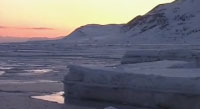 |
NASA | GSFC | JPL | Site Map |
|
|
 |
 |
Education: Student Outcomes |
Click here to search for other assets Melting Ice, Rising Seas: Studying Change in Ice Sheets & Glaciers Grade level: 9-12 Themes: climate, ocean circulation, water cycle Video: melting_ice_02.flv
Lora Koenig: "What we're seeing right now on the ice sheets and glaciers is that they are shrinking in size. And as glaciers on land are shrinking overall, that contributes a little bit to sea level rise. And we are worried that as we see warming over the ice sheets, and increased melting over the ice sheets, that they are going to start contributing much more to sea level rise." (source) Student Outcomes After viewing this video, students should be able to: Explain how climate variations can induce changes in the global ocean circulation. (C: 9-12) Explain the relationship between fresh water and ocean dynamics. (W: 9-12) Determine if global precipitation, evaporation, and the cycling of water are changing. (W: 9-12) Key: C = climate / O = ocean circulation / T = 21st century technology / W = water cycle |
|||||
